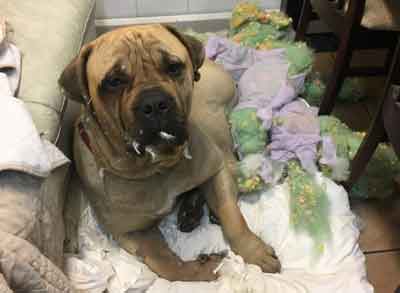Dogs can develop separation anxiety when they are left on their own. They may display destructive behavior due to stress. Separation anxiety is a problem that must be dealt with.

The signs your dog shows when they have separation anxiety
They will show distressed behaviors when they have been separated from their owner. Hyperactivity and destructive behaviors are common. Most people mistakenly believe that the dogs are mischievous.

Separation anxiety in dogs can be:
- Just by chewing on furniture or scratching windows and doors, you can be destructive.
- They may wee or poop in the home even if they’re potty trained.
- Excessively howl, bark or whine
- Circularly pant around your house
- Drool more than usual
- Escape the confinement area.
Separation anxiety is evident if your dog exhibits the above symptoms. You can use cameras to monitor what your dog is doing when you leave him alone. This will help determine if your dog suffers from separation anxiety.
What causes separation anxiety in dogs?
It is difficult to pinpoint the exact cause of separation anxiety. The majority of cases of separation anxieties are in adopted dogs. Separation anxiety is more likely in dogs raised with a loving family. Separation anxiety is caused by a variety of factors.
- The household will change
- Changes in the ownership or guardianship
- If there are changes to the schedule
What is the best way to treat separation anxiety in dogs?
Separation anxiety can be overcome by your dog. Here are some of the solutions to separation anxiety.
Counterconditioning
The counterconditioning method is used to train dogs in order to alter their response and behavior towards stimuli that are completely different than the initial behaviour or response. This is a form of dog behaviour therapy.
If your dog is afraid of a particular place, think about ways you can help him feel comfortable there. Give your dog some treats or have them perform activities they like. Repeating this behavior many times can help your dog to overcome their fear and be happy there.
Exercise
Separation Anxiety in dogs can also be helped by exercise. Exercises that are both physical and mental can help. If you force your dog to exercise, they will become tired and want to sleep. It is easy to let your dog rest when they are tired and show no separation anxiety. Exercises of the brain can help treat separation anxiety.
Medicines
Treatment of separation anxiety may require more than just training and exercises. Sometimes, medications can be just as important. Amitriptyline is the medication that is most commonly prescribed by vets for dogs who have separation anxiety. This medication is often used to treat anxiety disorders, depression and panic attacks.
Consult your veterinarian before giving any medication to your dog.
Developing Independency
Do not be too clingy with your pet and instead teach him independence. Allow your pet to be left alone every now and then, rather than staying close by all the time. Leave your home naturally and calmly without exaggeration. You should be cool and not show your love to the dog when you get home. It can reduce separation anxiety.